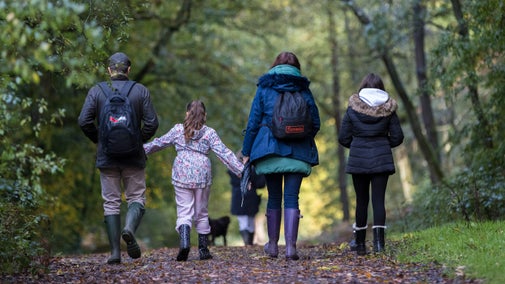
Donate
Everyone needs nature, now more than ever. Donate today and you could help people and nature to thrive at the places we care for.

Discover more about our work at Hatchlands Park that is helping wildlife to thrive. Find out how we’re counting butterflies are part of a national monitoring scheme. Learn more about our work to provide new homes for the hazel dormouse in the woodland and kingfishers at the pond.
Hazel dormice are under threat nationally due to changes in woodland management, farming practices, loss of hedgerows and the fragmentation of woodland. They’re a protected species in Britain and regarded by government as a priority for conservation action.
Their preferred habitat of dense, deciduous woodland, coppice and thick shrubbery is a feature of our parkland and woodland. Recently an expert from the Surrey Dormouse Group confirmed that these tiny creatures are making their home at Hatchlands in the hazel trees.
We’ve set up a dormouse project to help these tiny mammals thrive. The next step in our work involves helping them through the winter by providing nesting boxes in the woodland and forming the first dormouse monitoring area at Hatchlands Park.

With nationwide declines reported across a number of Britain’s most common species, we’re working hard, along with the UK Butterfly Monitoring Scheme, to help reverse that trend.
Butterflies are uniquely placed to act as barometers of the state of the environment, allowing us to assess the impacts of climate change and the progress of initiatives to conserve biodiversity. They’re a perfect indicator species, with rapid lifecycles and high sensitivity to environmental conditions.
At Hatchlands Park we’ve designed and set up our first butterfly transect with help from Bill Downey, the Transect and WCBS Coordinator for Butterfly Conservation Surrey and SW London.
A transect is a fixed-route walk where butterflies are recorded on a regular basis over a number of years. Transect routes are chosen to evenly sample the habitat types and activity on site.
Butterflies are recorded each week from the beginning of April to September, when weather conditions are suitable for butterfly activity. These set conditions can have a considerable effect on the numbers of butterflies seen and so ensure that the counts are standardised as much as possible.
The Hatchlands transect takes in a large area of the estate that includes Sheepwash Pond, the Wildflower Meadow, the Parterre Garden and Centenary Woodland. To date we’ve recorded a number of different species including brimstone, small white, orange tip, small copper, small tortoiseshell, meadow brown, common blue, large white and red admirals.

Sheepwash Pond is our largest expanse of water on the estate and a valuable habitat resource, as well as being used by the local community as a fishing pond and a peaceful picnic spot for our visitors.
We want to do more to help serve the population of kingfishers that we regularly see in the park. Kingfishers are cavity nesters, with most species nesting in holes they dig into earth banks on the sides of ponds, streams and rivers. We’ve helped them by creating pre-built tunnels and tubes for kingfishers to move in.
The pond had also previously suffered from erosion which has caused the silt levels in the water to increase. We set about creating new banks using reclaimed wood and silt collected from built up areas of the pond. These new banks were the perfect location to place the new homes for kingfishers.
The pond and surrounding area is also home to a number of fish including wild carp, bream, roach, perch and pike, 15 species of dragonfly and damselfly, wildfowl, bats and other aquatic invertebrates. This wide variety shows that our efforts at the pond are working and we will continue to monitor the site into the future.

Everyone needs nature, now more than ever. Donate today and you could help people and nature to thrive at the places we care for.
Explore six beautifully restored rooms, see some of Robert Adam’s earliest work, plus wonderful collections of paintings and musical instruments in the Cobbe Collection.

Discover the best bits of the parkland at Hatchlands. Spanning over 400 acres and just 45 minutes outside Greater London you’ll find a fun outdoor adventure, whatever the season.

Discover more about the 250-year history of Hatchlands Park, the families that made it their own and the influences of famous architects and designers of their day.

This incredible collection of over 40 keyboard instruments at Hatchlands Park is one of the largest of its kind in the world. Discover a few of the collection highlights.

We believe that nature, beauty and history are for everyone. That’s why we’re supporting wildlife, protecting historic sites and more. Find out about our work.

Read about our strategy, which focuses on restoring nature, ending unequal access and inspiring more people.
